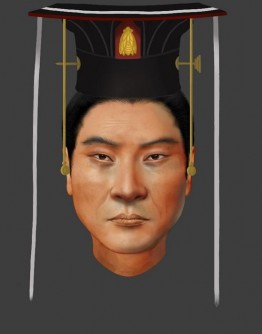Newswise — A team of researchers used DNA to reconstruct the appearance of Chinese Emperor Wu of Northern Zhou, who lived 1,500 years ago. Published in Current Biology, the study suggests his death at 36 might be linked to a stroke, shedding light on the origin and migration patterns of the nomadic empire. Emperor Wu, ruling from AD 560 to AD 578, unified northern China after defeating the Northern Qi dynasty. He belonged to the Xianbei nomadic group, with facial features typical of East or Northeast Asians, contrary to some scholars' assumptions. Archaeologists found his tomb in 1996, enabling DNA recovery and 3D facial reconstruction, revealing brown eyes, black hair, and dark to intermediate skin. The analysis suggests Emperor Wu's increased stroke risk aligns with historical descriptions of his symptoms. Additionally, it indicates intermarriage between Xianbei and Han Chinese during southward migration. This sheds light on ancient Eurasian integration. Future research aims to study ancient Chang'an city residents' DNA, the capital of numerous Chinese empires and a key point on the Silk Road. Understanding migration and cultural exchange in ancient China is pivotal.
close
- Login
-
News keyboard_arrow_right
Latest News Coronavirus News Currently Embargoed News Research News Releases Google Fact Check Research Alert Preprints Marketplace News with Video/Audio Multimedia
 RSS
Medicine keyboard_arrow_right
Biotech Cancer Coronavirus/COVID-19 Clinical Trials Diabetes Genetics Infectious Disease Neuro Obesity Women?s Health View all Medicine Channels arrow_right_altSciencekeyboard_arrow_rightChemistry Climate Science Dinosaurs DOE Science News Engineering Materials Science Physics Space View all Science Channels arrow_right_altLife keyboard_arrow_rightBehavioral Science Education Government History Politics Social Media View all Life Channels arrow_right_altBusiness keyboard_arrow_right Journal News keyboard_arrow_rightCell (journal) JAMA Journal of Experimental Medicine Nature (journal) NEJM Neurology (journal) PLoS View all Journal Channels arrow_right_altBy Location keyboard_arrow_rightAfghanistan News African News China News Cuba News Europe News Germany News Gulf of Mexico India/Pakistan News Iraq News View all by Location Channels arrow_right_altMeetings, Grants, and Events keyboard_arrow_right
RSS
Medicine keyboard_arrow_right
Biotech Cancer Coronavirus/COVID-19 Clinical Trials Diabetes Genetics Infectious Disease Neuro Obesity Women?s Health View all Medicine Channels arrow_right_altSciencekeyboard_arrow_rightChemistry Climate Science Dinosaurs DOE Science News Engineering Materials Science Physics Space View all Science Channels arrow_right_altLife keyboard_arrow_rightBehavioral Science Education Government History Politics Social Media View all Life Channels arrow_right_altBusiness keyboard_arrow_right Journal News keyboard_arrow_rightCell (journal) JAMA Journal of Experimental Medicine Nature (journal) NEJM Neurology (journal) PLoS View all Journal Channels arrow_right_altBy Location keyboard_arrow_rightAfghanistan News African News China News Cuba News Europe News Germany News Gulf of Mexico India/Pakistan News Iraq News View all by Location Channels arrow_right_altMeetings, Grants, and Events keyboard_arrow_right - Experts keyboard_arrow_right
- Journalists
- Pricing
- About keyboard_arrow_right
- Blog FAQ Help
